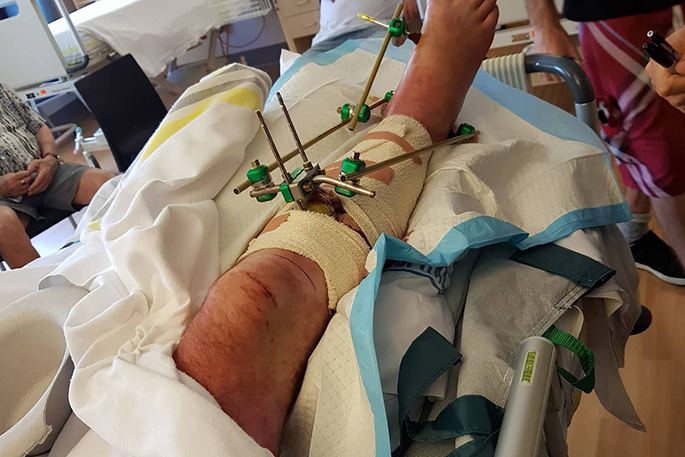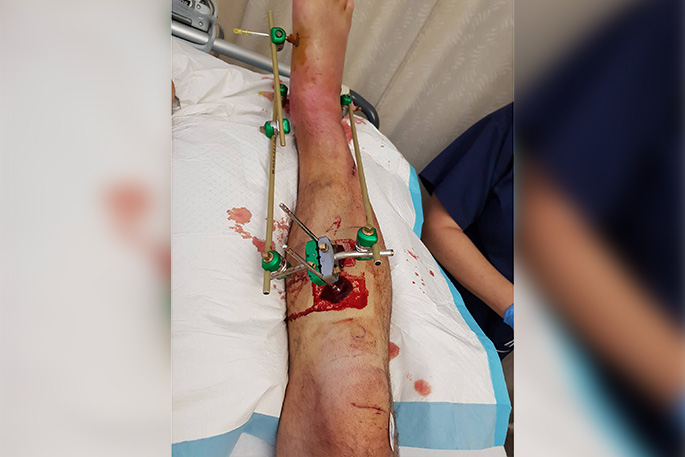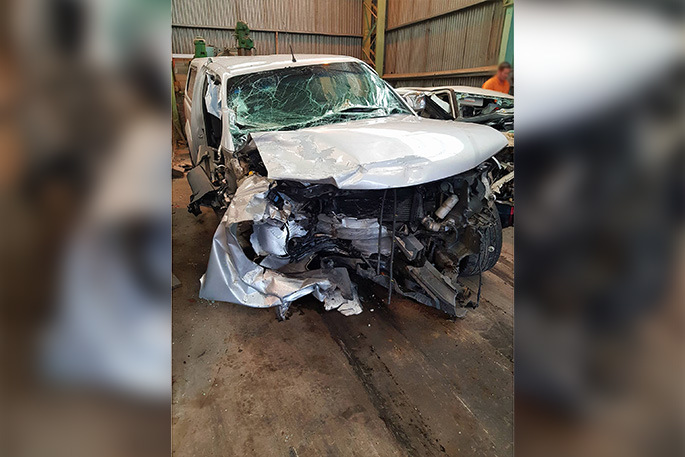A Waihi man faces a long road to recovery after his leg was badly broken in a car crash near the intersection of Turner Road and State Highway 2.
The January 13 accident put Mike Broad and his son Joshua Kinnaird in hospital, while the driver of the other vehicle died at the scene.
Mike and Joshua were heading home to Waihi late on that Saturday evening after visiting Baypark Speedway.
They were travelling through what locals refer to as the ‘Apata bends' when a vehicle that was allegedly speeding, crossed the centreline and crashed into them.
Mike's wife Brigid Broad recently posted about the accident in the Facebook group ‘Fix the BLOODY Road'.
'The phone call I got at 11.45pm on January 13 was the stuff nightmares are made out of,” she says.

In hospital with a broken leg.
'This has affected our lives hugely especially [Mike's] as he now has a rebuilt leg full of plates that was caused from [the] impact of [the] crash.”
She says son Joshua was lucky to come away with only bad bruising and a dislocated thumb. Mike, meanwhile, spent three weeks in Tauranga Hospital, and is still going back for regular check-ups.
'That means driving past the crash site and that road again... we don't look forward to those visits,” says Brigid.
Acting Western Bay of Plenty road policing manager Senior Sergeant Wayne Hunter says the crash is still under investigation.
'In any event police will be unable to comment until either a prosecution or coronial hearing has taken place.”

An x-ray of the damage to the leg.
POLICE: 'WE DON'T WANT TO SEE ANY MORE PEOPLE DIE ON OUR ROADS.”
Following a number of fatal crashes in the past week, road policing assistant commissioner Sandra Venables says she is as frustrated as everyone else that people continue to be killed on New Zealand roads.
'These deaths mean there are now families, friends, and colleagues who will carry a lifetime of grief. They will miss out on the usual life milestones that other families get to enjoy with their loved ones,” she says.
'Every day we talk about the same circumstances where lives have been lost through a driver taking unnecessary risks and putting themselves, their passengers, and other road users in harm's way.
'We want everybody to understand the responsibility they have to protect themselves and their passengers, as well as all other road users."
She says simple things such as being respectful and courteous on the road, having a focus on getting to the destination safely, having plenty of time so you can take breaks, and not taking unnecessary risks, can make a difference.
'Being a few minutes late is better than not making it there at all."
New Zealand Transport Agency safety and environment director Harry Wilson says every death on our roads is a tragedy.
'Road deaths are not just numbers, and we never lose sight of the real human loss and grieving behind these figures,” he says.
'The transport agency is supporting the efforts of police to target enforcement activity on a number of high risk roads to reduce deaths and injuries.
'At the same time we are delivering the government's Safety Boost programme, a $22.5 million programme of targeted improvements to make 30 regional state highways safer."

The roads are in Northland, Taranaki, Manawatu-Wanganui, Canterbury, Otago, and Southland and are being upgraded with rumble strips and better signs.
Crash-preventing safety barriers will also be added to some roads.
'These are relatively simple, but effective, improvements which can help prevent deaths and serious injuries,” says Harry.
'For example, rumble strips can reduce all crashes by around 25 per cent and fatal run-off-road crashes by up to 42 per cent.
"As part of the Boost programme we are also investigating the installation of more rural intersection activated warning signs (RIAWS) at a number of high-risk intersections on other state highways around the country.”
RIAWS are electronic signs that reduce the speed limit on the state highway (usually from 100 km/h to 60km/hr or 70km/h) if a vehicle is turning into or out of a side road.
RIAWS signs are already being successfully used at 13 locations on state highways around the country to improve intersection safety with minimal delays for road users.
The NZTA is currently holding public consultation on 10 RIAWS sites throughout the country, however none of these are in the Bay of Plenty.



4 comments
Blame what is relevant
Posted on 21-03-2018 15:36 | By hapukafin
its not the road.its that idiot that cant stay on his side of the road at fault if that is the case.was he under the influence of anything,I hope the coroner releases that.If it was the road most of the users would crash there.
Don’t blame FIX
Posted on 21-03-2018 18:21 | By waiknot
This road highlights the deficiencies in peoples driving more than other roads. So clearly the road needs looking at. You can rant & rave about it being the drivers not the road, that wont fix it. More escape opportunities, better visibility at intersections, a medium barrier protecting me from oncoming traffic. All would be welcomed.
The road is relevant...
Posted on 21-03-2018 19:58 | By GreertonCynic
That piece of "State Highway" is nothing more than a glorified goat track with some tar seal.
It’s a combination
Posted on 21-03-2018 21:35 | By namxa
Way too much traffic for the road design now. No room for error at all. Not even the slightest over/understeer.Thats a mean break, tib n fibhad the same 30 years agonot nice.Hope ur recoverys a speedy one mate.
Leave a Comment
You must be logged in to make a comment.